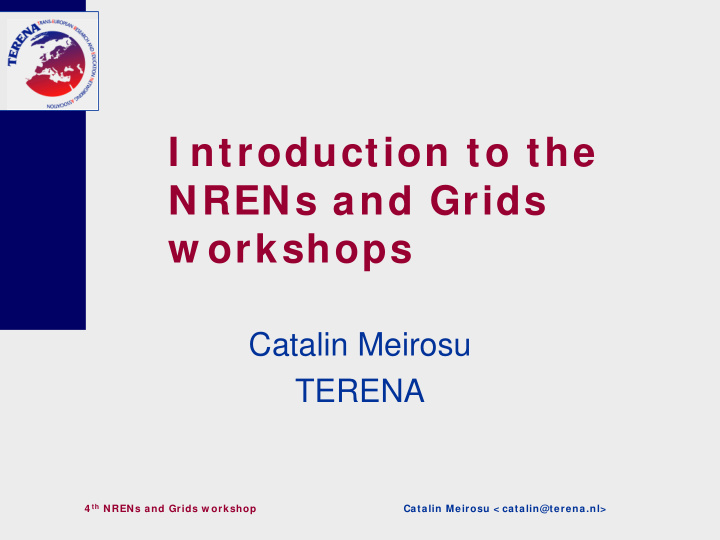



I ntroduction to the NRENs and Grids w orkshops Catalin Meirosu TERENA 4 th NRENs and Grids w orkshop Catalin Meirosu < catalin@terena.nl>
Overview • NRENs ? • Grids ? • Common issues, common approaches • Overview of past workshops • NRENs and Grids, 4 th edition • SLA basics 4 th NRENs and Grids w orkshop Catalin Meirosu < catalin@terena.nl>
W hat are NRENs ? Uni 1B Uni 1a Uni 2a IT Services IT Services IT Services Slide adapted from NREN 1 NREN 2 Licia Florio Géant2 4 th NRENs and Grids w orkshop Catalin Meirosu < catalin@terena.nl>
NRENs today • Providers of connectivity and services on top of the bandwidth • Large and heterogeneous user community • Services (non-exhaustive!) – Connectivity: generic (IPv4, IPv6) or dedicated (lightpaths, circuits, BoD, Premium IP) – Network Operation Centres – Computer Security and Incident Response Teams (CSIRTs) – AAA collaboration beyond institutional boundaries: federations (eduroam); conferedations (eduGAIN) 4 th NRENs and Grids w orkshop Catalin Meirosu < catalin@terena.nl>
W hat is a Grid ? • Beyond Web++ “The flexible, secure, coordinated resource sharing among dynamic collections of individuals, institutions, and resources.” (Ian Foster et al) • Categories of shared resources – Storage – Computing power – Scientific instruments: particle accelerators, electronic microscopes, radio-telescopes • Addressing the need of certain categories of expert, power users, for a coordinated problem solving environment 4 th NRENs and Grids w orkshop Catalin Meirosu < catalin@terena.nl>
Grids today • From distributed computing experiments to running a reliable infrastructure • Developer and User communities increasing – Overlaid on classical organisational structures • Sharing resources raises issues of: – Trust – Policy: access, usage – Negotiation – Payment – … 4 th NRENs and Grids w orkshop Catalin Meirosu < catalin@terena.nl>
Com m on issues case study: AAI • Both NRENs and Grid AA aim at: – sharing resources across organisational boundaries using fine grained AuthN and AuthZ • Using same CA for NRENs and Grids – Already accomplished: shared PKI in a number of countries • Toward a common AAI for both Grid and NRENs Slide adapted – Preliminary ideas: from Licia Florio • grid cert for eduroam authN, • eduGAIN user id for accessing the grid, • using federation middleware for controlling lightpaths ex: GLIF 4 th NRENs and Grids w orkshop Catalin Meirosu < catalin@terena.nl>
TERENA NRENs and Grids w orkshops • One aspect of TERENA’s support for the Grid community • Mandate – Exchange information on current practice – Reach a common understanding about the likely impact of Grids on NRENs – Investigate the organisational and political issues that need to be addressed – Consider which initiatives and/or projects need to engaged • First edition, broad spectrum • Second edition, focus on AAI • Third edition, focus on Grid security aspects 4 th NRENs and Grids w orkshop Catalin Meirosu < catalin@terena.nl>
4 th TERENA NRENs and Grids w orkshop • Focus on the interoperability of network resources and Grids – Service Level Agreements - definition and implementation in campuses and NRENs – End-to-end SLA issues for Grids – Automatic configuration of network resources in a Grid environment – Network monitoring frameworks in NRENs and campuses, and integration with Grid middleware – Fault detection and interactions between networks and Grids in such cases 4 th NRENs and Grids w orkshop Catalin Meirosu < catalin@terena.nl>
SLA – basics • Contractual agreements between a service provider and a service consumer – aim 1: describe the service through a set of parameters and agree on minimal values • details customer needs and priorities • shields the provider from unreasonable demands • tool for objective performance assessment – aim 2: specify commitments for each party • identify responsibilities • describe the workflows for resolving service disruptions • Good intro talk: M. Gerndt, “Automatic Performance Tuning of Grid Applications Based on Service Level Agreements”, http://www.lrr.in.tum.de/~gerndt/home/Vita/Presentations/2006/Aurora.pdf 4 th NRENs and Grids w orkshop Catalin Meirosu < catalin@terena.nl>
SLA – w hat can be covered • Every service can be described by dissecting it according to categories (category = what there is in terms of most general kinds of entities, Aristotle). See T. Sandholm, “The Philosophy of the Grid: Ontology Theory – From Aristotle to Self-Managed IT Resources”, http://www.pdc.kth.se/~sandholm/trita/SandholmOntologyV2.pdf • Example – Grid computing job – Substance: bandwidth, storage, cpu power – Quantity: 10 Mb/s, 1 TB, 30000 SpecINT2k marks – Quality: 99.999% reliability – Place: list of 101 locations in Europe – Time: during peak hours – State: scheduled, running, finished – Action: schedule, run, migrate – Affection (as in “the state of being affected”): the job transitions from “scheduled” state to “running” state when … 4 th NRENs and Grids w orkshop Catalin Meirosu < catalin@terena.nl>
SLA – beyond the paper • Measurement and monitoring • Auditing • Optimisations – Allocating resources based on SLA promises – Reconfiguration of resources in case of SLA violation • All these are end-to-end issues 4 th NRENs and Grids w orkshop Catalin Meirosu < catalin@terena.nl>
4 th TERENA NRENs and Grids w orkshop • Focus on the interoperability of network resources and Example: data transfer Grids bandwidth – Service Level Agreements – definition, implementation and end-to-end issues • any rules for combining SLAs? – Monitoring and measurement Where (place) issues – (N/G)OC • Where, when, how – What happens if something breaks? (N/G)OC OSI level 4 th NRENs and Grids w orkshop Catalin Meirosu < catalin@terena.nl>
Recommend
More recommend